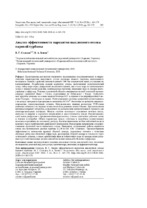Анализ эффективности вариантов выхлопного отсека паровой турбины

Date
2020Publisher
Another Title
Analysis of the Effectiveness of Variants of the Exhaust Compartment of a Steam Turbine
Bibliographic entry
Солодов, В. Г. Анализ эффективности вариантов выхлопного отсека паровой турбины = Analysis of the Effectiveness of Variants of the Exhaust Compartment of a Steam Turbine / В. Г. Солодов, В. А. Конев // Энергетика. Известия высших учебных заведений и энергетических объединений СНГ. – 2020. – № 4. – С. 365-379.
Abstract
Представлены результаты численного исследования газодинамических и энергетических характеристик выхлопного отсека цилиндра низкого давления, включающего последнюю ступень с рабочей лопаткой длиной 1100 мм и выхлопной тракт, в условиях их взаимовлияния. Разработаны модели вариантов отсека, включающие межступенчатый зазор, отбор пара перед диафрагмой последней ступени, два отсоса пара из межвенцового зазора с камерой влагоудаления, надбандажные протечки, инжекцию пара из камеры влагоудаления в диффузор. Течение в расчетной области описывается полной системой нестационарных уравнений Навье – Стокса, осредненных по Рейнольдсу – Фавру. Турбулентные эффекты описаны на основе модели Ментера SST в ступени и модифицированной модели Спаларта – Аллмараса в тракте. Интегрирование системы уравнений осуществлялось с помощью авторского программного комплекса MTFS. Расчетные подобласти аппроксимировались гексагональными сетками. Использовалась неявная разностная TVD-схема конечных объемов 2-го порядка точности на базе решения задачи Римана. При вычислении применяли вариант алгоритма, основанного на расщеплении вычислительного процесса для многопроцессорных платформ. Модель ступени использует осреднение потоков массы, импульса и энергии в окружном направлении в межступенчатом зазоре. Рассчитывались один канал диафрагмы с предвключенным фрагментом, а также один канал рабочего венца и течение в патрубке. Обмен параметров между ступенью и патрубком осуществлялся на основе осреднения по массовому расходу. Расчеты выполнены на базе табличной модели влажного пара в приближении равновесной конденсации. Рассмотрены направления совершенствования проточной части выхлопного отсека. Выполнено исследование работы вариантов отсека для номинального режима турбины К-220-44-2М АЭС «Ловииса». Проанализирована эффективность понижения крышки сборной камеры, управления потоком с помощью листовых ребер над обечайкой диффузора, расширения сборной камеры в плоскости горизонтального разъема, а также организации выхода избыточного пара из камеры влагоудаления через тангенциальные щели в нижней половине выпуклой оболочки диффузора.
Abstract in another language
The results of a numerical study of the gas-dynamic and power characteristics of the exhaust compartment of low-pressure cylinder, including the last stage with a blade of 1100 mm length and the exhaust path, in terms of their interaction are presented. Numerical models of exhaust compartment variants, including steam extraction in front of last stage diaphragm, two steam suctions from the interring gap with a dehumidification chamber, above-band leakages, steam injection from the dehumidification chamber into the diffuser channel have been developed. The flow in each computational subdomain is described by the complete system of non-stationary Reynolds – Favre equations averaged by Navier – Stokes. Turbulent effects are described with the SST Menter model in the stage, and with the modified Spalart – Allmaras turbulence model in the path. The integration of system of equations was carried out using an author’s software package. The calculated subdomains were approximated by hexagonal grids. The solver used an implicit difference TVD-scheme of finite volumes of the 2nd order of accuracy based on the solution of the Riemann problem. A variant of the algorithm based on splitting the computational process for multiprocessor platforms was used in the calculation. The model of stage used an averaging the mass, momentum and energy fluxes in the circumferential direction in the interstage gap. One channel of the diaphragm with a preconnected fragment, as well as one channel of the working ring and the flow in the branch pipe were calculated. Parameters were exchanged between the stage and the branch pipe on the basis of mass flow averaging. The calculations were based on a table model of wet steam in the approximation of equilibrium condensation. The variants of improvement of the flow part of the exhaust compartment were considered. A study of the operation of the compartment options for the nominal mode of the K-220-44-2M turbine of the Loviisa nuclear power plant was performed. The effectiveness of lowering the cap of the collecting chamber, controlling the flow using sheet ribs above the diffuser shell, expanding the collecting chamber in the plane of the horizontal connector, and ensuring the release of excess steam from the moisture removal chamber through the tangential slots in the lower half of the convex shell of the diffuser were analyzed.
View/
Collections
- № 4[7]
